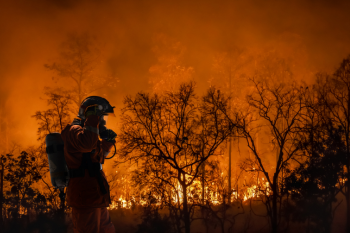by Mary Manning, Heidelberg IWC and 3rd Vice President, Global Issues
 In May 2016, a wildfire broke out in the forests surrounding Fort McMurray, in the province of Alberta, Canada. The unseasonably hot weather and low humidity turned the wildfire into a raging inferno, and 88,000 people were forced to evacuate the town in a matter of hours, miraculously without any immediate fatalities. The fire destroyed or damaged more than 4,000 homes, eventually spreading across 1.5 million acres, and was the costliest disaster in Canadian history. It was declared to be under control in July of that year, but it continued to smolder, and was only fully extinguished in August 2017.
In May 2016, a wildfire broke out in the forests surrounding Fort McMurray, in the province of Alberta, Canada. The unseasonably hot weather and low humidity turned the wildfire into a raging inferno, and 88,000 people were forced to evacuate the town in a matter of hours, miraculously without any immediate fatalities. The fire destroyed or damaged more than 4,000 homes, eventually spreading across 1.5 million acres, and was the costliest disaster in Canadian history. It was declared to be under control in July of that year, but it continued to smolder, and was only fully extinguished in August 2017.
Fort McMurray also happens to be the beating heart of Canada’s petroleum industry, specifically for the production of bitumen, whose extraction from the Alberta oil sands is particularly expensive and damaging to the surrounding environment.
Fire Weather examines climate change and the environment through the lens of this disaster. Specifically, the fact that the frequency and gravity of wildfires is only increasing, as is the frequency with which we will use the superlatives “largest,” “costliest” or “deadliest.” We are now seeing wildfires in the Artic tundra, which would have been unheard of just a few decades ago.
“During this first century and a half of the Petrocene Age, as we have harnessed, democratized, and amplified fire on demand, we have also unleashed some unintended consequences: a by-product of becoming a petroleum-based society – in other words, a fire-based society – has been the superheating of the atmosphere.”
I learned so much from reading this well-researched and well-written book. The author examines the history of the petroleum industry and how we moved into the “Petrocene” age in the early 20th century. He also addresses just how much petroleum is part of the products and clothing we use every day. In one very interesting example, he cited an experiment by the Fire Safety Research Institute in which they tested the burning of two living rooms. The first was set up with “legacy” furniture and fixtures, e.g., wooden tables and chairs, lace curtains, cotton upholstery and stuffing for the couch, etc. The second had “modern” furnishings, made of synthetic materials, resins and glues. The modern living room began producing toxic smoke at around two minutes and in less than five minutes had reached the flashover point – at which the entire room has ignited and temperatures are over 500°C. In the legacy room, instead, the fire burns and spreads slowly through the room, not reaching flashover for almost 30 minutes. (I encourage you to watch the side-by-side video of the experiment, it is truly eye-opening).
Mr. Vaillant also examines the history of climate change, and I was surprised at how the scientific data was widely accepted in the 1950s and 1960s, including by the petroleum industry. The politicization and denialism came later, and only now that climate change can no longer be refuted is the industry finally starting to address the issue. I also learned that a woman can be credited with the first climate change experiment.
“If one were to ascribe a specific date to the dawn of modern climate science, a strong case could be made for August 23, 1856 – though its significance went unrecognized for 150 years. Eunice Newton Foote was an artist, inventor, citizen scientist, and early suffragist from upstate New York whose singular contribution to climate science was lost in plain sight until a retired petroleum geologist stumbled over it in 2010. Without knowing it, Foote conducted and described what could be called the first modern climate change experiment.”
Foote filled two cylinders, one with ordinary air and the other with CO2, and heated them by exposing them to direct sunlight. She demonstrated that the one filled with CO2 grew twice as hot in a matter of minutes and noted that “an atmosphere of that gas would give to our earth a high temperature.”
I also learned that not only does fire depend on certain weather conditions, it has the ability to create its own weather systems, including hurricane-force winds, lightning bolts, and even fire tornadoes. The author even makes the argument that fire is similar to a hunter: it grows, breathes and even moves toward nourishment.
Like most books on climate change, Fire Weather is not easy to read. The author dives deep into the history of how we got to where we are, but he does not address climate mitigation efforts and how we can change our path. In addition, he focuses more on the effects of higher temperatures and wildfires and not on other effects such as rising sea levels. However, I can highly recommend this book for all those who wish to more fully understand what is behind the increasingly common new stories about wildfires around the globe.

